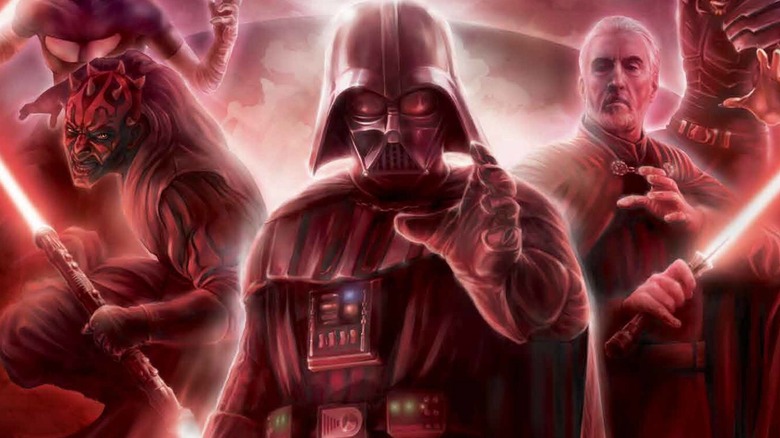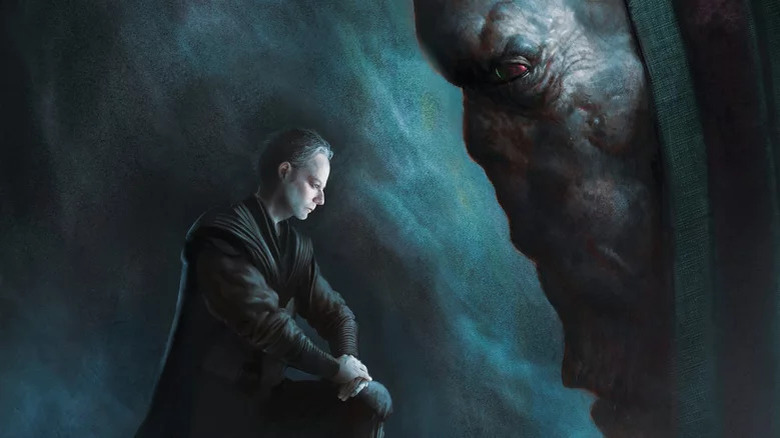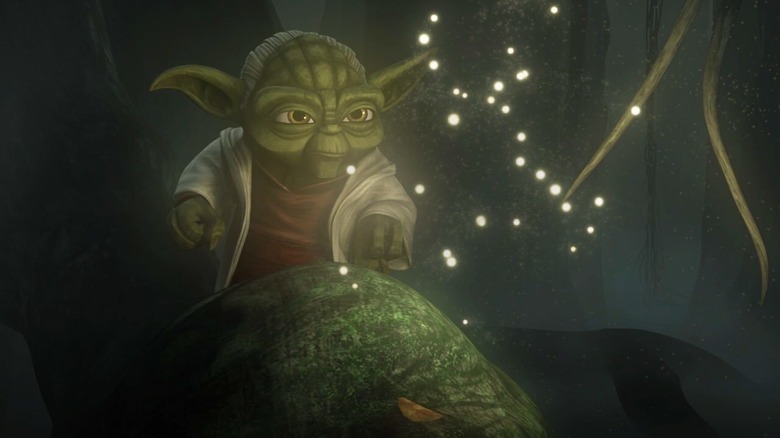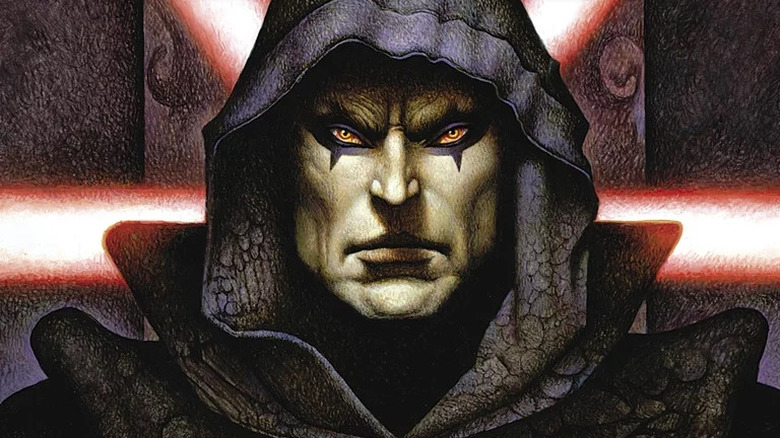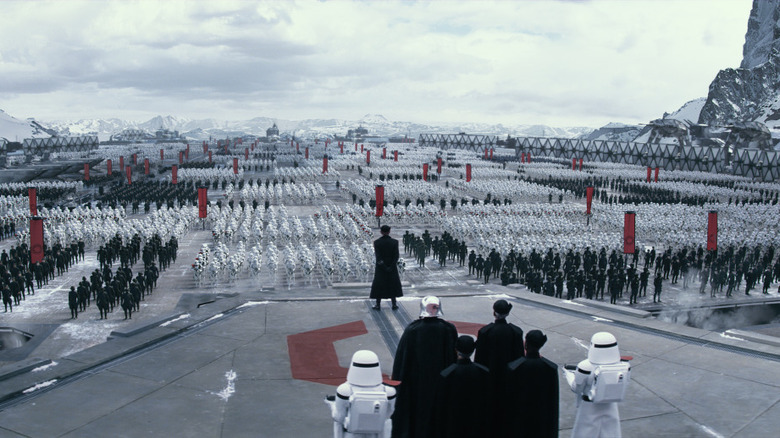What Is Star Wars' Code Of The Sith? The Dark Side Mantra Explained
"Peace is a lie," the poem begins, "There is only passion. Through passion, I gain strength. Through strength, I gain power. Through power, I gain victory. Through victory, my chains are broken. The Force shall free me."
Six simple sentences that have led souls toward the despair of evil and helped them drag a galaxy with them down into that abyss. You see, this is the Code of the Sith (the "Qotsisajak") from "Star Wars," the practitioners of the dark side of the Force.
This mantra was written by David Gaider while writing for the 2003 video game "Star Wars: Knights of the Old Republic," as part of the game's divulging into the background of the Sith. It has since been embraced by the "Star Wars" canon, appearing in plenty more media thereafter. When Darth Maul first returned as a delirious wreck in "The Clone Wars," his actor Sam Witwer (a "Star Wars" superfan) suggested he be incoherently reciting the Sith Code. Appropriately enough, the Code is also quoted in the 2021 book "Secrets of the Sith" by Marc Sumerak.
The meaning of the Code is plain enough, but what do these words reveal (especially since their origin lies in an evil far more real than a cult of malevolent space wizards)? Let's break it down.
The Way of the Sith
The Sith Code stresses the might of the individual. The route to enlightenment (for lack of a better term for the dark side) begins with one's passions. After all, no one gets to the top without a burning drive inside them, and the top is where a Sith Lord must sit; what use is power unless you have foes to defeat and subjects to bend to your will?
The "Star Wars" novel that best explores the Sith's philosophy is "Darth Plagueis" by James Luceno. Don't let the fact that it belongs to the non-canon "Star Wars Legends" dissuade you. Plagueis, master of Darth Sidious/Palpatine, serves his apprentice wisdom extrapolated from the Sith Code:
"Remember why the Sith are more powerful than the Jedi, Sidious: because we are not afraid to feel. We embrace the spectrum of emotions, from the heights of transcendent joy to the depths of hatred and despair."
Instead of letting go of emotions, the Sith reshape the outer world to the designs of their inner one. Rather than submitting themselves to the will of the Force, the Sith wield its power and wisdom as just more weapons. Submitting to the Force could never bring a Sith to inner peace; that would mean strengthening the invisible chains the code calls for them to shatter. Plagueis (really Luceno) continues:
"We [the Sith] are the select few who refuse to be carried by the Force, and who carry it instead. Thirty in a millennium, rather than the tens of thousands fit to be Jedi [...] For the dark side is only for those who value self-determinism over all else existence offers."
The Jedi counterargument
In "The Empire Strikes Back," Yoda (Frank Oz) warns Luke Skywalker (Mark Hamill) that the dark side of The Force is not stronger than the light, but rather "quicker, easier, more seductive." After all, it's much easier and immediately satisfying to give in to your passions than trying to control them. The Jedi are monastic and preach about maintaining a cosmic "balance," unlike the Sith who seek to make the world obey them. Compare the Jedi code (of which the Sith version is a corruption):
"There is no emotion, there is peace.
There is no ignorance, there is knowledge.
There is no passion, there is serenity.
There is no chaos, there is harmony.
There is no death, there is the Force."
The Jedi Code is self-improvement in a different way than the Sith; detach yourself from your desires instead of letting them grow into all-consuming ambitions. All a Jedi should be seeking for themselves is greater understanding.
In particular, note the last line of the Jedi code. In "The Clone Wars" season 6, episode 12, "Destiny," we get an explanation of how death works in the "Star Wars" universe. All life connects to the Living Force, and upon passing, that essence is transmuted, becoming part of the greater Cosmic Force.
For a Sith Lord, ruled by the individual drive to dominate and excel, such a fate would be hellish; it constitutes the loss of identity and consumption by something greater. Hence, the Sith search for physical immortality or necromancy, for the end result would mean victory over the last chain that still binds them: death.
Channeling passion
The Sith Code valorizes a life lived uninhibited — which is inevitably a problem for a structured organization. Every Sith Lord believes themselves to be superior and/or lives their life in a way to make themselves so. As such, other Sith are not comrades; they are rivals to be used or slain.
"The urge to kill one's superior is intrinsic to the nature of our enterprise," says Plagueis while warning Sidious of how the younger Sith will grow to hate him during their training.
Thus, a millennium before the "Star Wars" films, one survivor of Sith infighting, Darth Bane, created the Rule of Two. There may only be two Sith at a time, a master and an apprentice. When the student grows strong enough, they kill their teacher and then take a disciple of their own, repeating the cycle.
If the Sith stopped following their code of greed and selfishness, they'd no longer be the Sith. However, Bane's Rule of Two takes those qualities and works them to the benefit of the Sith lineage, not just individual Lords. The idea is George Lucas' own, but author Drew Karpyshyn got to show the origins of it (at least as far as "Legends" go) firsthand with his "Darth Bane" novel trilogy. Bane summarizes his tenet:
"Two there should be. No more, no less. One to embody power, the other to crave it."
Star Wars pulls from real evil
Gaider didn't develop the Sith Code out of nowhere. No, he pulled from "Mein Kampf" ("My Struggle"), Adolf Hitler's autobiography/antisemitic screed written after his failed "Beer Hall Putsch" in 1923. Fascism is inherently contradictory (it promotes a warrior mindset in its followers, urging them to fight and die as the hero of the story, while also stressing allegiance to a strong state and devotion over individual will). The Sith Code splits the difference; rugged individualistic will-to-power narrative for the Sith themselves, bootlicking for those they triumph over.
This isn't the only Nazi imagery employed for villainous ends in "Star Wars." The Empire in the original trilogy and the First Order in the sequels are styled after the Third Reich. In the prequels, Palpatine's rise is comparable to Hitler's; an evil man swindles a desperate population, gets himself elected leader, and destroys the crumbling democracy that elevated him.
Alarmingly, fascist sentiment is now on the rise like it was in the early 20th century. In 2018, Gaider remarked on Twitter:
"Once upon a time, my telling folks that 'Mein Kampf' was the inspiration for Sith philosophy in ['Knights of the Old Republic'] made them stop [admiring it]. Not so sure that'd be the case these days."
But then again, the dark side (in the "Star Wars" world and ours) wouldn't be so dangerous if it wasn't also alluring. The easiest path to evil is when there's something in it for you, which is why the Sith Code begins with passion.
